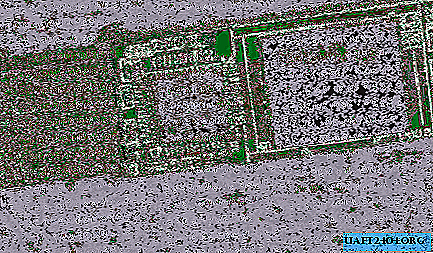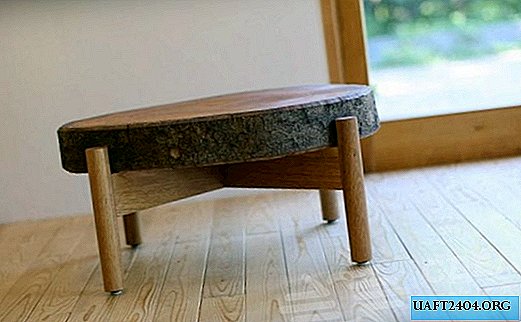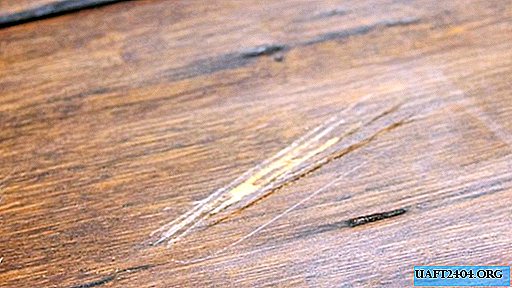Share
Pin
Tweet
Send
Share
Send
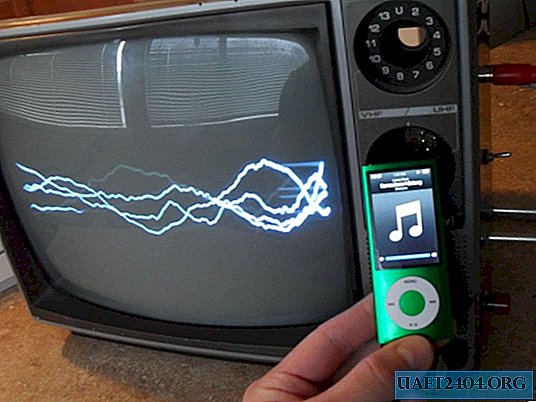

Various instructions have been posted on the Internet to turn an old (sometimes partially inoperative) television into a widescreen oscilloscope. This article will also tell you how to create a decent electronic device using a simple refinement with a total cost of about $ 20. In order for the input signal to be displayed on the screen and played through the TV speaker, you need to assemble a simple device that commutes the power circuit of the deflecting system. Of course, you can’t extend the large frequency spectrum on such an instrument (actually 20-20000 kHz), but it’s quite possible to track low-frequency vibrations.
You can also install the main connectors and control elements of the device in the television case (fortunately, this allows space). For example, the presence of an RCA connector will be a great opportunity to connect an iPod and at the same time allow AC power input from millivolts to hundreds of volts. Nearby you can place a tuning resistance of 1 mOhm and a 6-section rotary switch. With a small trimmer it will be convenient to control the horizontal sweep frequency, and a bright red button is suitable for turning on the device.
It remains to add that this connection scheme is not suitable for all TV models and is more useful for people who can handle circuitry and have experience in electronics. But the idea itself contains many interesting points.
Safety requirements
The implementation of the described project involves work next to an open television transformer and high-voltage capacitors. The voltage at the magnetron reaches 120 kV! In order to exclude the possibility of fatal electric shock, proper safety precautions must be strictly observed. The first step to any action should be a complete blackout of the device. Here we must not forget about high-voltage capacitors. Therefore, the protective cover of the high-voltage unit is removed very carefully. It is important not to damage the circuit board wires and not to touch its open contacts.
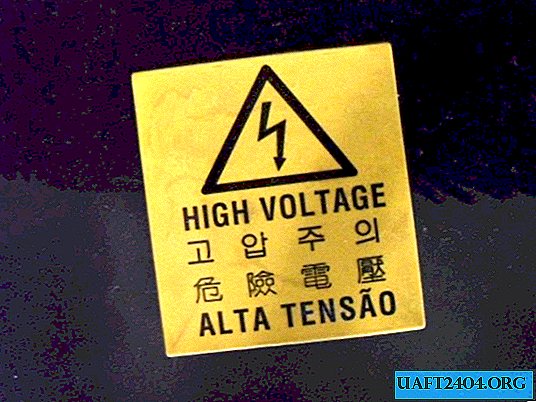


Next, you need to force discharge large capacities (50 V or more). This is done with a well insulated screwdriver or tweezers. Their contacts are closed to each other or to the housing until complete discharge. Do not do this on a printed circuit board, as tracks may burn out. When performing work or testing the device, make sure that there is someone close to you who can call a doctor or provide first aid.
Principle of operation
Television-ray tube (CRT) televisions and oscilloscopes are considered the most interchangeable devices. Also, a television receiver is more complex than a basic laboratory oscilloscope. For its alteration, it is enough to get rid of some of the TV functions embedded in it and add a simple amplifier. After all, each expandable line of the TV screen creates an electron beam, quickly scanned through the transparent material of the luminescent substrate of the tube.


Charged electrons are controlled by electric and magnetic fields created by coils located behind the tube. These cores with a wire deflect the beam in the horizontal and vertical plane, controlling the location of the image on the screen. To adjust it in the center of the oscilloscope line, you need to make some adjustments with them.



We recall that the video signal produces 32 frames per second, each of which consists of two "interlaced" images (that is, 64 frames are scanned). The NTSC standard defines 525 lines in screen format, other standards have slightly different values. This means that for the reproduction of a filled picture on the screen, the electron beam must be deflected vertically every 1/64 second (frequency 64 Hz), and horizontally 1 / (64x525) seconds (frequency 32000 Hz). To ensure such values, the voltage of the horizontal transformer exceeds 15,000 volts. In this case, the device works like a TV, and creates a detailed image on the screen.
To make him draw an image on a very thin line, vertically rejected by the input signal, you need to adjust the number of turns of the screen coils. It is also important to "work" with the inductor coil. Its impedance is frequency dependent. The higher the frequency, the more difficult it will be to display it on the screen. With an outer diameter of the toroidal core of 10 mm and a thickness of 2 mm, windings I and III must contain 100 turns of PELSHO 0.1 wire, and winding II - 30 turns.
It is also worth remembering that the signal in the TV is mathematically integrated. This leads to the fact that the input rectangular wave will be displayed on the screen triangular, and the triangular - a sinusoid. This applies only to images, but not sound. Sine waves will be displayed without distortion. The phenomenon will not be so noticeable in very old TVs that can display white noise or a blue screen in the absence of a signal, and not automatically turn off the image.
Removing Redundant Nodes
In our case, we used an old television receiver with a 15-inch screen and a classic UHF / VHF tuner. To create an oscilloscope, it is not required, so the tuner can be immediately removed and forget about its existence. You can also gradually turn off the extra modules one by one, checking that the TV can still function. You only need the main board and everything that is connected to the picture tube. It is necessary that it only displays white noise or a blue screen. You can just free the box from the rest of the parts.




There were two potentiometers on the front of the converted TV. One of them served to turn on and adjust the volume, and the other controlled brightness. Both were removed: the first was replaced by a power switch (big red button), the second had to be set to maximum brightness and fixed by soldering additional resistances into the circuit. You should immediately pay attention that a device with a built-in volume control for rework is not suitable. It amplifies the signal attached to the television and you will have to look for an amplifier on the main board, and this will cause additional problems. Speakers at this stage can also be turned off.
Deflection System Preparation
In order to achieve an oscilloscope picture on the kinescope screen, it will be necessary to apply the generated amplified signal of frame and horizontal sync pulses to the deflecting coils H and V. How to get it will be disassembled a little later, and now it is necessary to prepare a deflecting system. The coils are connected to the main board with four pins. It is necessary to disconnect the horizontal, red and blue wires go to it. By connecting an iPod or a computer directly to these outputs, you can get music display on the tube screen. The vertical coil has a yellow and orange wire, but to get a 64 Hz scan they need to be switched to a horizontal coil.


Now you need to find where the coils are connected to a small circuit board on the tube of the tube. If the television is not very new, there are only two coils and 4 wires from them to the main board. Otherwise, there will be more coils and in this form the alteration will not work. But do not quit what you started, and you can experiment a little. In the meantime, we assume that the wires are still 4. It remains to deal with the wires going to the tube. According to the rule of the right hand (F = qVxB), we remove one of them in a random order. If a horizontal line is displayed on the screen when the device is turned on, the vertical coil is disabled, if it is vertical, then vice versa. The corresponding ends are found by the tester and marked.
Now the horizontal coil connection wires are removed from the main circuit board. Do not forget that you will have to deal with a frequency of 30,000 Hz and a voltage of more than 15,000 volts. The future oscilloscope does not need them. Before touching, they must be short-circuited, then insulated well and placed inside the case so that they do not touch anything after turning on the device. So, the 60 Hz vertical marking line is ready. To obtain the same horizontal line of 60 Hz, the two remaining wires going to the vertical coil are soldered to the horizontal one. And the vertical will be the input of the oscilloscope to connect the amplifier circuit.
Scan Setup
The further part of the work is the most dangerous, as it will be performed when the voltage is connected. Be especially careful! We are trying to connect the signal source to a vertical deflecting coil (it can be an MP3 player or a computer headphone output). To display a single frequency on the screen, try to generate a stable tone. When the TV is turned on with an insulated screwdriver, carefully touch the high-voltage wires in turn, finding out what changes on the screen it will lead to (your assistant should watch for this or use a large mirror).




One of them will affect the scanning frequency. On the board where it enters, you need to solder the tuning resistance (approximately 50-60 kOhm). After making sure that the unit is operational, you can remove the handle of the involved resistor from the device body. Even a perfectly executed horizontal frequency setting will not allow you to see the upper range, but only displays the scroll waveform on the screen. You can also customize the existing annular tabs located around the narrow part of the tube of the tube. Usually they are black or dark gray and also indirectly control the final image.
Input gain
Everything that was done up to this moment allowed us to create a good visualizer of the input signal. Enough to connect the iPod jack to the coil of vertical deviation and sounding music will be displayed on the screen. But in order to get a real oscilloscope, you need an additional amplifier (you can assemble it where the discarded UHF / VHF tuner was located). His idea was borrowed from several thematic sites, with the aim of obtaining minimum cost and maximum efficiency. The development of Pavel Falstad was taken as the basis, and the presented circuit board was a modified circuit of a two-stroke audio amplifier.
To implement it, we need: a micro-assembly TL082, including 2 op-amps, a pair of transistors (for example, 41НПН / 42ПНП), power regulator LM317, rotary switch "Pole", potentiometer 1 mOhm, two trimers 10 kOhm, 4 diodes 1A, transformer 30 V AC, electrolyte 1000 μF 50 V, two electrolytes 470 μF 16 V and 5 resistors (10 Ohm, 220 Ohm, 1 kOhm, 100 kOhm and 10 mOhm).



The first op-amp controls the gain of the input signal according to the formula R1 / R2, where R1 is the resistance selected by the rotary switch, R2 is a 1 mΩ pot. Theoretically, it is able to amplify the input signal up to 1 million times (with a minimum of 1 ohm available on the rotary switch). The second ensures that the transistors receive the necessary voltage to open the junctions and compensates for distortions. They need 0.7 V for opening and 1.4 V for switching.
The finished circuit requires mandatory calibration. The power regulator is designed for a difference of 30 V, so the op-amp will standardly output + 15 / -15 V, but for good filtering, its output should be several volts lower than the voltage at the capacitance of 1000 microfarads. To do this, there is a trimmer 1. The circuit output is connected to a horizontal deflection coil. Music that is passed through the circuit begins to “cut off” from above / below. To avoid this, trimmer 2 is adjusted until the upper parts of the clips touch the edges of the screen. This will lower the voltage and prevent the transistors from overloading the RF path of the device (burn the deflection coil).
Now you can connect the built-in speaker system to the TV output. At excessive volume, a large load resistance is added (for example, 10 Ohm 1 W), with a lack of sound, the load resistance is put on the deflection coil, after which the latter is recalibrated. To protect yourself from excessive annoying sound signals while viewing the necessary input signal, you can install a switch on the speaker.
Assembly all together
An additional amplifier can generate a strong magnetic field, so you should take care of its design. The board should be as compact as possible, with short leads and good grouping. She does not need special shielding, but in order to avoid interference with other TVs in your home, make sure that it is located in the case, without causing interference to the main nodes. In extreme cases, you can use a wooden or plastic case, glued inside with foil.



In the disassembled TV, when removing the analog tuner, enough space was freed up for the installation of a transformer with such a board, and even an opening for the power switch came up. It is also desirable to shield the transformer so as not to interfere with the TV channels. Connect the terminals for connecting the synchronization voltage and the test signal to the board only with a shielded wire.
After connecting the transformer to the circuit, connect S1 and S2, respectively, run the input wires through the hole in the television receiver, connect the circuit output to the speaker and the reject coil. Use the minimum wire length in all conductive connections to reduce the dissipated inductance of the circuit. It remains to find a convenient installation location for S1 and S2, close the back cover and proceed with the test drive.
Checking device performance
By its functionality, the assembled oscilloscope is far from worthy laboratory models, but is indispensable for use in simple projects where you want to see the waveform. Also, a certain novelty has the ability to hear the signal under study, especially when receiving feedback resembling “signs”. In this example, we can observe a change in the signal induced by a conventional wire coil when it is located in an arbitrary place, above the instrument’s internal transformer and when it is above the laptop processor.
The ability to amplify the incoming signal is a great feature if you do not need its absolutely accurate parameters. The noise of the frequency of 60 Hz, amplified by the circuit, can so far be determined with a sufficient error. But this phenomenon also causes stray inductance of the input wire. Only shielded grounding of all parts of the circuit can reduce interference.


The demonstrated coil with a wire connected to the input of the device allows the use of a large inductance with strong gain. She can detect power sources for several meters, directing the coil in the direction of the transformers, and then visually see their work. You can also detect the location of the processor inside a complex device. You can use the coil as an inductive microphone by placing it near a speaker playing music. The magnetic field reproduced by the speaker coil will be detected and amplified by the created device, after which the played music will be reflected on the oscilloscope tube.
You can visually view on the device and the operation of the Internet channel. A dedicated home line (120 VAC) was used as an input signal for this, and, having shown its “picture”, the device still works.
Original article in English
Share
Pin
Tweet
Send
Share
Send





